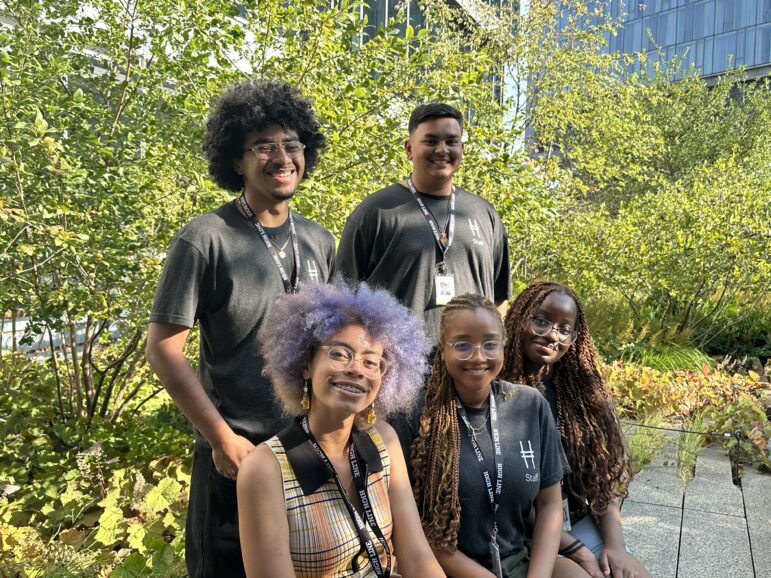The workforce development program allows teens to explore how city spaces can be repurposed for greater sustainability.

Jillian Peprah-Frimpong
Participants in the High Line Teens program, a paid year-round employment opportunity that immerses teens in civic engagement, horticulture, and arts and culture at the vibrant public greenspace.This story was produced by student reporters in City Limits’ CLARIFY News program
Growing up as a kid in the Chelsea-Elliott Houses, Joaquin Eleno didn’t see a lot of green space.
“Before the High Line was really developed to something, there wasn’t like anything” besides a small playground and cherry tomato tree by the entrance of a nearby pizza shop, he recounted.
With renovations and gardens of the High Line taking root in 2009, Eleno said the elevated park—which over the years has spurred both praise and controversy—was a welcome addition.
“When the High Line started getting developed, that was probably my first introduction to [green space],” said Eleno, who will be attending Borough of Manhattan Community College as a freshman this fall.
A visit by City Limits’ CLARIFY News staff to the High Line on Aug. 9 found it buzzing with families attending a “Keep It Wild” workshop celebrating the garden’s native species, completely staffed by teens like Eleno.
They’re members of High Line Teens, a paid year-round employment program that immerses young New Yorkers in civic engagement, horticulture and art at the public greenspace, which stretches 1.45-miles across Chelsea. Participants, usually locals, build professional skills while they play a role in shaping the neighborhood’s cultural and physical landscape.
“I’m from the area, so I feel like the High Line is one of the few green spaces that are actually accessible to the community,” said Aniyah Cameron, a Chelsea native and part of the program’s “civic engagement pathway,” which involves teens in the local politics and public works projects of City Council District 3. The park, Cameron said, “gives us a space that we don’t have to sign up for or reserve.”
For Eleno, the program’s promise of greater civic involvement aligned with his goals. “I want to improve my city,” he said.
The teens carry out community and Council-approved projects using “The People’s Money,” the first citywide participatory budgeting process where residents decided how to allocate $5 million of the city’s budget to community needs (in Manhattan, residents voted to fund youth vocational and housing resource outreach programs.)
The teens also collaborate with neighborhood stakeholders, including local Councilmember Erik Bottcher, to deliver public programs like family workshops and tours, and to help maintain the High Line’s many gardens.
Both Cameron and Eleno pointed out a contrast in the sparse greenery in their neighborhoods to the exclusive green spaces found around upscale condos, or to other parts of the city that have access to larger residential parks.
Manhattan Community Board 4, where the majority of the High Line is located, has just 7 percent parkland—compared to 23 percent citywide—and ranked 54th out of the city’s 59 community districts when it comes to tree canopy cover, according to a 2021 analysis by New Yorkers for Parks.
Lawmakers and environmental advocates are working to increase the city’s tree canopy cover, which they say is crucial as global temperatures reach record-breaking highs. Expanding green spaces can help cool the urban landscape, mitigate air pollution and absorb stormwater that leads to flooding.
Recently, Botcher introduced a bill that would require the Parks Department to create an Urban Forest Master Plan to protect and increase the urban forest. For years, open space advocates have also pressed the city to allocate at least 1 percent of its annual budget to parks maintenance and programming (the Parks Department receives roughly 0.6 percent of the city’s current spending, according to New Yorkers for Parks).
Staff in the High Line Teen’s horticulture pathway operate as seasonal stewards of the High Line’s gardens, including “The Prairie,” a section of park between 22nd and 23rd streets with plants and grasses native to the Great Plains.
“The teen staff is able to come in and help weed out those invasive species to make sure the garden grows out and is beautiful, especially during the summer,” Nehyandé Winslow, a teen on the horticulture pathway said.

Jillian Peprah-Frimpong
High Line Teens participants helped plan public workshops about native plants at the greenspace.Teens also conduct tours with different partners and youth programs, exploring the park’s biodiversity. “This year the theme is about native plants so we tour around some of the native plants on the High Line and just give them a rundown of the symbiotic relations that they have with humans,” said Winslow.
The program also allows teens to discuss the significance of repurposing spaces in the city for greater sustainability, such as the abandoned elevated rail line on which the High Line is built.
“For me personally, it’s all about accessibility,” said Keisha Lewis, a Bronx native and a participant on the High Line Teens’ civic engagement track. “The Bronx doesn’t really have as [many] green spaces as we would like.”









